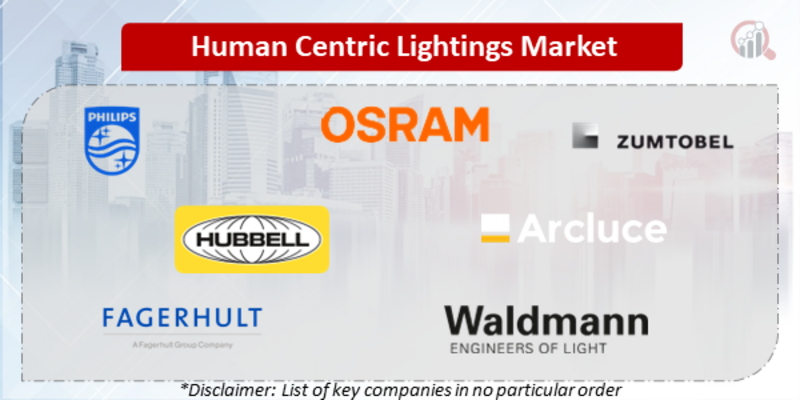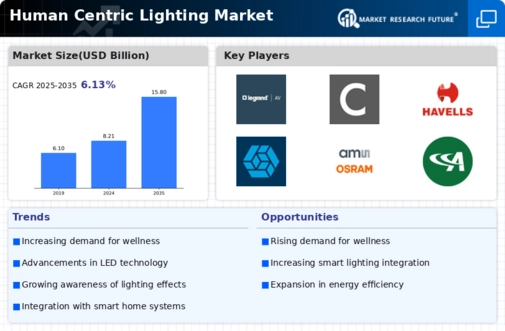Top Industry Leaders in the Human Centric Lightings Market

Competitive Landscape of Human Centric Lighting Market
The human-centric lighting (HCL) market, illuminating a path towards well-being, fueled by growing awareness of the impact of light on human health and performance. This dynamic space presents a kaleidoscope of players, with established lighting giants battling for dominance alongside innovative startups carving their niches.
Some of the Solenoid valve companies listed below:
- Koninklijke Philips NV
- Osram Licht AG
- Zumtobel AG
- Hubbell Inc.
- Arcluce S.p.A.
- Fagerhult AB
- Waldmann Lighting
- Glamox
- ES-SYSTEM S.A.
- CoeLux S.r.l
- Legrand SA
- Seoul Semiconductor Co Ltd
- NormaGrup Technology
Strategies Adopted by Players:
-
Technological Differentiation: Players compete fiercely on technological advancements, focusing on factors like spectral tuning, circadian rhythm simulation, and dynamic light control. Integration of AI, biofeedback sensors, and advanced software algorithms is gaining traction. -
Product Portfolio Diversification: Expanding offerings beyond core lighting fixtures to include control systems, sensors, and software suites is crucial. Catering to diverse application needs like classrooms, offices, hospitals, and residential spaces fuels market penetration. -
Strategic Partnerships and Collaborations: Collaborations with research institutions, architects, and interior designers enable access to new expertise, accelerate product development, and enhance customer solutions. Partnering with wellness and healthcare providers also holds promise. -
Focus on User Experience and Branding: Building user-friendly controls, providing customized lighting programs, and highlighting the health benefits of HCL are vital for customer engagement and differentiation. Establishing brand identity as a provider of "healthy lighting" solutions plays a key role.
Factors for Market Share Analysis:
-
Revenue Generated: This straightforward metric reflects a company's market penetration and financial strength. -
Unit Shipment Volume: Understanding the number of HCL lighting fixtures sold provides insight into customer adoption and market reach. -
Technological Innovation: Assessing a company's investment in R&D, patent portfolio, and technological breakthroughs helps gauge its future competitive edge. -
Customer Satisfaction: Analyzing customer feedback and loyalty metrics reveals how effectively a company caters to customer needs and builds brand reputation.
Latest Company Updates:
July 11, 2023- Legrand's lighting control brand Vantage announced a strategic alliance with the Lucetta brand from Elemental LED in LHUMAN Light Fixture Alliance. The partnership will enable Lucetta to supply its robust low-voltage linear lighting solutions that pair seamlessly with Vantage's LHUMAN human-centric lighting (HCL) solution. This will allow installers to create lighting scenes with precise color temperatures to fit the user's desired ambiance, lighting environment, and lifestyle.
Mar.07, 2023- Human-Centric Lighting Startup Kumux (Barcelona) announced raising over $500K in a funding round. The company uses its algorithms to improve lighting control systems' functionality greatly. Lighting software company Kumux develops human centric lighting software that uses geolocation, time of year, and activity alongside lighting control systems to run circadian lighting routines within buildings more efficiently and smartly.
Nov. 25, 2022- AiSPIRE, the lighting brand from WAC, launched its upscale AURORA line of luminaires, AiSPIRE AURORA, designed for connected living. AiSPIRE AURORA features full visible spectrum color-tuning LED lighting. Thus, offering human centric recessed down lighting supporting the needs of the modern technologist and integrator. Using a control system, AiSPIRE controls luminaires can create different moods suitable for the hour's activity.
Sep. 14, 2022- Nichia introduced an 'azure' colored LED for human-centric lighting, aiming at circadian lighting. Its azure LED is the 3 x 3 x 0.8mm NF2E757H-F1, which produces 29.5 lm at its nominal 65mA 2.74V (~180mW). The 480nm light stimulates the secretion of serotonin and activates the human body and mind. The more serotonin secreted in the morning, the more melatonin, a sleep hormone, is secreted 14 to 16 hours later, using it as a source.
